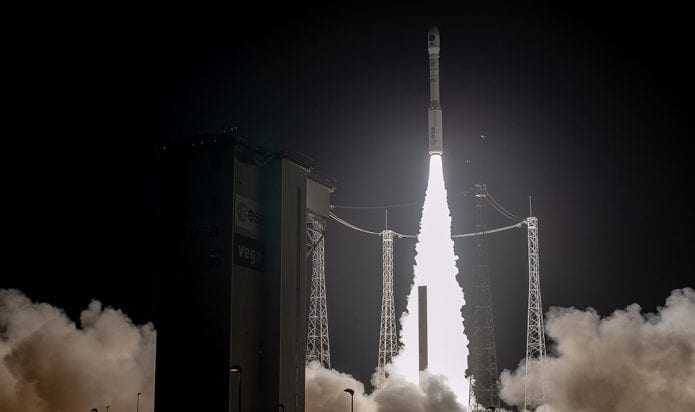Arianespace Successfully Launches Italian Earth Observation Satellite

Arianespace launching Italy’s Prisma satellite on a Vega rocket. Photo: Arianespace
Arianespace successfully launched the Italian Space Agency’s Prisma satellite on a Vega rocket at 10:50 p.m. local time from the Guiana Space Center (CSG) in French Guiana. Prisma is the 600th satellite to be orbited by Arianespace and the eigth for Italian institutions or operators.
Prisma was built for the Italian Space Agency by OHB Italia as prime contractor, with Leonardo responsible for the payload. Lofted by Vega into Low Earth Orbit (LEO), Prisma aims to provide major applications to protect the planet and ensure Italy’s environmental safety. The satellite is fitted with an electro-optical instrument, comprising of a hyperspectral sensor and a medium-resolution panchromatic camera (sensitive to all visible wavelengths), and will employ these capabilities for environmental monitoring, the management of resources, identification and classification of crops, the fight against pollution, etc.
Following the launch, Arianespace Chief Executive Officer (CEO) Stéphane Israël said, “With today’s successful launch of the PRISMA Earth observation satellite, Arianespace has orbited its 600th satellite! We are very proud to continue performing our primary vocation of ensuring independent access to space for Europe, with a focus this evening on Italy. Today’s mission, carried out for the Italian space agency, ASI, and the Italian industry consortium led by OHB Italia and Leonardo, illustrates the reliability of the Vega launcher, which has performed its 14th successful launch in a row. It also confirms the launcher’s attractiveness as a champion of the Earth observation market, since Arianespace now has 9 Vega and Vega C in its launch order backlog. Our third successful mission of the year, following launches by Ariane 5 and Soyuz last month, reflects the excellence and complementary fit of our family of launch vehicles.”